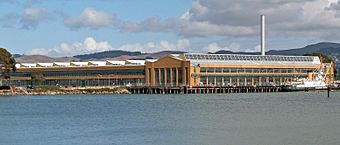Ford Motor Company Assembly Plant facts for kids
Quick facts for kids |
|
|
Ford Motor Company Assembly Plant
|
|
 |
|
| Location | Richmond, California |
|---|---|
| Built | 1930 |
| Architect | Albert Kahn |
| NRHP reference No. | 88000919 |
| Added to NRHP | June 23, 1988 |
The Ford Richmond Plant was a very important factory in Richmond, California. It was the largest car assembly plant ever built on the West Coast. During World War II, this plant changed its work to help the United States' war effort.
Today, the plant is part of the Rosie the Riveter/World War II Home Front National Historical Park. It is also listed on the National Register of Historic Places, which means it's a special historical site. The building now holds the National Park Service visitor center, many businesses, and a place for events called the Craneway Pavilion.
Building the Ford Plant
The Ford Assembly Plant was built in 1930, during a tough time called the Great Depression. It is a huge building, almost 500,000 square feet (about 46,450 square meters). This factory helped the local economy a lot. It also played a big part in developing Richmond's inner harbor and port.
Ford became one of the biggest employers in Richmond. It was behind only Standard Oil and the Santa Fe Railroad. The building itself is a great example of 20th-century factory architecture. It was designed by a famous architect named Albert Kahn. He was known for his "daylight factory" design. This meant his buildings had many windows to let in natural light. The main building has a two-story part, a single-story part, a special craneway, a boiler house, and a covered area over the railroad tracks.
Ford's Role in World War II
During World War II, President Franklin D. Roosevelt stopped the making of regular cars. This was to make sure America used all its factories to help with the war. The Richmond Ford Assembly Plant quickly changed its work. It started putting together jeeps. It also added the final touches to tanks, half-tracked armored personnel carriers, and other military vehicles. These vehicles were sent to the Pacific War zones.
By July 1942, military vehicles were coming to the Richmond Ford plant. They got their final checks before being shipped out to the war. The Ford plant was called the "Richmond Tank Depot" then. It was one of only three such depots in the whole country. This plant helped make sure American soldiers had the best and newest battle equipment. About 49,000 jeeps were put together here. Also, 91,000 other military vehicles were processed at this site.
Working together, the government and factories helped America's war effort. This close teamwork set the stage for what became known as the "military-industrial complex" later on. This plant was a key part of America's "Arsenal of Democracy" during the war. It is a historic part of how industries work in the United States even today.
After the War
After World War II, many factories closed, like the Richmond Shipyards. This could have hurt the local economy badly. But the Ford Plant kept making cars, which helped a lot. However, the last Ford car was made here in February 1953. The plant closed completely in 1956. Production moved to the San Jose Assembly Plant. This was because the Richmond plant could not keep up with the demand for more cars.
The old plant was even shown in a movie called "Tucker: The Man and His Dream." Filming started there on April 13, 1987.
In 1989, a big earthquake, the Loma Prieta earthquake, badly damaged the plant. After the earthquake, the City of Richmond fixed the building. They prepared it for new uses. In 2008, the building was fully repaired. New companies moved in, like SunPower Corporation and Mountain Hardwear. The large craneway part of the building, now called the "Craneway Pavilion," is used for many events. These include banquets, weddings, and company gatherings. In 2018, the Craneway Conference Center hosted an opera festival. In April 2020, officials from Contra Costa County announced a plan. The Craneway Pavilion would be turned into a 250-bed hospital. This was for COVID-19 patients who did not need intensive care. The California National Guard helped set up this special facility.




